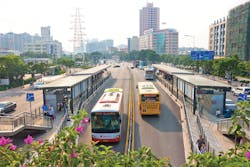Keeping Quiet: A Guide to Acoustics in Transportation Hubs
When I was a kid, going to the airport was just shy of being an astronaut. Not quite as cool, but very close. The scalloped mid-century ceilings, entire walls made of glass, perfectly smooth and polished floors, everyone so happy and friendly, smartly dressed in their flight uniforms. For me, it was like Disneyland – but with real jets. And of course, there was the fascinating echo of the main lobby, which my brother and I hooted and hollered loudly into with glee until my mother caught us.
Acoustics in transportation hubs like airports, train stations and rapid transit bus stops should not be ignored, as they impact us more than we think. With over a century of mechanized travel behind us to learn from, we now know that even 10 hours a week of regular travel can be exhausting due to auditory fatigue alone. In major cities, a significant portion of the population drives or commutes an hour each way to work five times a week. With growing numbers of the population commuting into cities, transportation has become a key element in urban design and, consequently, acoustics.
ACOUSTICS 101 SERIES: Part 1 / Part 2 / Part 3 / Part 4 / Part 5 / Part 6 / Part 7 / Part 8
Historically, transportation hubs have architecturally been grand, awe-inspiring places with very large, tall spaces and, therefore, very large air volumes. Even to this day, the style remains relatively the same with cleaner, modern lines and in some cases, even grander designs. Terminals are now stories high, include enormous floorplans capable of holding tens of thousands of travelers, and even feature unique elements like abundant natural daylight and a prolific use of glass, both as exterior walls and interior elements. Airports have become our modern, worldwide non-denominational houses of worship with travel and transportation being the new deity. Ironically, despite the evolution of architecture since the Taj Mahal was built, our modern day travel-churches often sound very much like their predecessors.
Material Acoustics
Acoustics is tied inexorably to materials. Hard surfaces result in echoes and reverberation, leading to noise, fatigue, unintelligibility and overall poor-sounding spaces. Most airports, train terminals and bus stops are made with metal, stone, tile, glass or some variety of hard surface. Consequently, these new spaces acoustically replicate the historical spaces which they replace. Yet in relation to acoustic isolation, they are light years ahead. Why, then, is the acoustic signature (the quality of the sound inside the space) less important than the acoustic isolation (the control of noise) from airplanes, trains and buses? It is because loud noises from machinery bother humans much more than an interior space, which sounds like a large cave. It would seem the old adage is true: “The squeaky wheel gets the grease.”
Acoustic signature is the subjective measure of how “good” a space sounds, while acoustic isolation is how much sound is kept out of or inside a structure. In the case of transportation hubs, acoustic isolation is already well executed, so we’ll focus on the acoustic signature; how the sound of large airport terminals, train stations and bus stops make us feel. In general, most people like quieter spaces with less reverberation and no echo. Like a dark, quiet ‘70s style steakhouse, it is simply easier and less fatiguing to have a conversation and be able to understand the conversation without having to extend a great deal of effort just to hear someone speak.
These quieter, “better” sounding spaces give one a sense of peace and calm. Despite the challenges of even larger spaces filled with hard, reflective surfaces, this is easily achievable, thanks to new acoustical technology and creative designs. Materials can be integrated into the architecture and interior design, serving dual purposes: acoustic control and architecture. Today, with the proper mindset and knowledge of materials, an urban transportation hub designer can simultaneously achieve a sense of grandeur and intimacy, acoustically.
Airport Acoustics
A well-designed airport is truly inspiring. They are magnificent, cavernous monuments honoring the gods who conquered the skies. Short of teleportation, air travel has truly made the world a smaller place. One can traverse the globe faster and easier than ever before. As air travel continues to grow, so must airports. Airports are well traveled public spaces with enormous numbers of people passing through them daily. In 2012, LAX alone was home for a day to 175,000 travelers. By necessity, this type of traffic requires the use of durable and washable floors, walls, railings, kiosks and furniture. Because of this, the nature of high traffic public spaces is antithetical to a good acoustic environment.
The solution? Accept the high traffic areas, like floors, railings and kiosks, as a baseline requirement and address areas which have less wear and tear: walls above head high, ceilings, suspended artwork and seating. Except for seating, all of these areas have negligible wear and tear and are, in fact, completely out of reach of travelers. In these areas, dual- or triple-purpose acoustic devices, panels and materials can be used to control sound and provide isolation between spaces while also serving the architectural and interior design faithfully.
New acoustical wallpaper helps control moderate to low volumes of high frequency sound and can be used as an alternative to paint or other wall coverings. Artwork screened on acoustically transparent textiles and wrapped around quantum acoustic devices serve as the highest degree of sound control and can be arranged in exhibition format, creating a museum feel to a terminal space. Traditional absorption widely spread across large surface areas can help take the edge off high frequency reflections.
On challenging topologies such as curves, columns or structural membranes, CAT System panels can be easily applied. Designed for this very use, CAT system panels were designed as easily available, custom-sized panels in any polygonal shapes or size with the latest in new technology for traditional absorption.
Acoustical films applied to glass surfaces can both improve R-Values while simultaneously reducing acoustic reflections. Highly specific air flow patterns can be created by decreasing the temperatures near remaining hard surfaces, slowing down the speed of sound and thereby decreasing the volume of sound. Obviously this requires creative HVAC design with a clear understanding of thermodynamics, light and the behavior of large bodies of air. Where possible, adding custom seating with highly absorptive seat and back cushions, which must be both elegant and functional, can help trap sounds of seating areas when the seats are vacant. With the right design, durable, washable and acoustically absorptive seating can have significantly more acoustical impact than the industrial carpet below it, creating again a dual-purpose piece of furniture.
Naturally, these new technologies need to be integrated early into both design processes and preliminary budgets. As with most acoustical designs, there is a blend of tools, utilizing each device or panel in its most effective niche, both acoustically and economically. In practice, this typically means using the most effective/expensive quantum devices wisely in the most difficult areas, while the more economical traditional solutions are applied where simpler acoustical issues exist and absorption can be very effective.
Train Stations Acoustics
Unlike airports, most train stations do not even attempt to isolate the noise of the trains from the travelers. In fact, they place them together in different cavernous spaces with just as many or more hard, reflective surfaces as airports. The rare exceptions are subways in Singapore or Hong Kong, where the trains run completely enclosed until they are fully stopped. Only then do doors in the walls of the subway station open to allow entry to the subway cars. As you would expect, these are by far the quietest subway stations anywhere, by design.
Historically, train stations were massive, hangar-like auditoriums where all the train tracks culminated in one location so travelers could access any and/or all the trains together. However, in order to house that many tracks side by side, this meant the resulting space was enormous. Like airports, this also still (mostly) stands true. Grand Central Station in New York City is an exception. The architects wanted to have a human space that was not filled with soot, coal dust and train noise, but rather a clean, public area with restaurants, ticket booths and other services supporting travelers. This is why there are no trains in the terminal space of Grand Central Station – all the trains are underground. To reach them, you enter the terminal at street level and walk through pedestrian tunnels down to the train platforms below grade. Acoustically, this keeps the terminal quieter sans train and mechanical noises. Built over a century ago in 1903, this was a revolutionary concept and even more impressive in reality.
Acoustically, train stations share many of the same pitfalls as airports. They are designed with nearly 100-percent glossy, hard reflective surfaces, which again result in echoes, reverberation, poor intelligibility and auditory fatigue. In stations where the trains and people are all in one space, there is an even greater need for a good acoustical design since the largest noise creator is the train. To be fair, new trains are quieter than ever with maglev and electric trains. Yet our aim is to design transportation hubs that are quiet, comfortable and acoustically peaceful.
The solution? The same as airports only more so, with a focused eye on performance and ease of cleaning. As the mechanical transportation device is in the same space with the travelers, the noise floor is higher than in airports. Also, any emissions created or dirt encountered on its travels might be brought into the station with the train. With a higher noise floor, a higher degree of surface area must be acoustically controlled. This means a more complex design with more devices and panels. In this environment, a thermodynamic/HVAC solution would not be the best solution, as the improvement of the solution might be less than the already higher levels of noise. However, greater use of artwork-wrapped quantum devices as information kiosks between tracks would help mitigate cross track acoustical noise.
Creating a sense of division at specific places would serve to disseminate information, as well as steer travelers to their correct location. Again, cleanliness over time is of concern and will affect acoustical devices. Like an HVAC air filter, acoustical devices can become blocked or clogged by the dirt which builds up on the textile wrapping, limiting effectiveness dramatically by not allowing air to pass through. Overall, acoustical solutions for train stations include more surface area coverage with quantum devices, CAT System or traditional absorption panels, and multipurpose kiosks serving as acoustical control and information displays.
Acoustics in Rapid Transit Bus Stops
Bogota, Colombia had a city-wide transportation issue. The population outgrew the myriad of small bus lines, which worked poorly and took over two hours to travel only 30 km. In addition, the city did not want to spend large amounts of money for a light-rail/subway mass transit system. In 2000, the TransMilenio BRT, or Bus Rapid Transit system, was launched. This government-operated system uses interconnected lines of buses with bus stops on raised platforms down the middle of the road and exclusive bus lanes adjacent on both sides. Travelers reach the BRT stops via bridges and overpasses. Like subways, there are local and express buses.
This new style of rapid transit does not have large stations or terminals, but rather many small stops down the middle of the road where the buses stop. These steel and glass shelters are for loading and unloading passengers, as well as for protection against natural elements. Because they are smaller spaces made completely of hard reflective surfaces, they are loud and filled with echoes and reverberation. It is a shorter echo and reverb than airports and train stations, but it’s there nonetheless. As many of these are open-air and not acoustically sealed from street noise or bus noise, the average noise floor will be higher than an airport to start with. The BRT is an effective and economical system, and the acoustic solution should be as well.
I Hear Design: The interiors+sources PodcastIn these small metal glass enclosures, quantum devices would be wasted and the spaces are not tall, so acoustical devices above head height would be useless (except for the ceiling). The best solution for assuming limited effectiveness and a budget scaled to match the system would be traditional acoustical treatment or to use the CAT System for more elegant and artistic thin panels to control the hard reflections in these narrow, short spaces. Again, if the space is open to the street noise, one can only hope to control the sound once it’s in the bus stop, not to isolate it. The BRT is an unusual acoustical circumstance, so the higher ambient noise is simply part of the environment.
Acoustics Overview
People are now realizing the impact of auditory fatigue. An average commute in a loud, echoic environment can take up to 10 hours each week. That’s 10 hours of noise and vibration keeping people anxious and agitated. Transportation hubs, such as airports and train station, are large, echoic cavernous spaces with poor acoustics. Using intelligent design and a blend of new technology, high performance can be achieved by integrating dual-purpose acoustical materials and devices into the architectural and interior design process at an early stage.
Remember, the basics of acoustics is straightforward:
- Hard surfaces create reflections
- Reflections cause issues (echoes, reverberation, resonances, comb filtering)
- Issues cause low intelligibility, poor clarity and minimal phase accuracy
- I.E. hard surfaces make things sound poorly and make spoken word hard to understand
ACOUSTICS 101 SERIES: Part 1 / Part 2 / Part 3 / Part 4 / Part 5 / Part 6 / Part 7 / Part 8




